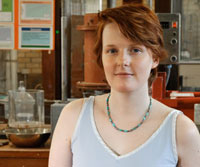| Sep 03, 2013 | |
Carbon nanotubes win three minute thesis at University of Sydney |
|
| (Nanowerk News) Civil engineering postgraduate student studying carbon nanotubes, Kate McDonell (YouTube profile), will represent the University of Sydney in the Trans-Tasman Three-minute Thesis (3MT) competition later this year after winning the University's finals of the competition. | |
 Kate McDonell 3MT competitors have just 180 seconds to present their thesis topic to a panel of non-experts. A simple explanation of her thesis project titled Structural modification of carbon nanostructures for improvement of mechanical properties won Kate the challenge. As part of her Phd research she is investigating the complex bond between nanotubes and the effects of electron irradiation. Kate who is completing her PhD in School of Civil Engineering explained carbon nanostructures are significant due to their extraordinary mechanical, electronic and structural properties. "A carbon nanotube looks similar to chicken wire rolled into a cylinder. Because of their composition they can be used as additives to various structural materials such as cable for space elevators, light sabre battery or body armour." Yet despite their individual immense strength, the intermolecular interaction of nanotubes causes them to slip and slide amongst each other. This can cause low shear strength," states Kate. |
|
| "The aim of my PhD is to improve the properties of groups of carbon nanotubes by creating bonds between them as a result of electron irradiation," says Kate. | |
| "When I fire electrons at the nanotubes it creates damage on their surface. Nanotubes are self-mending. One of the ways they mend themselves is to create bonds. | |
| But just like if we have a break in our skin, when the nanotubes mend themselves it doesn't mend perfectly. It leaves a scar." | |
| "I'm trying to control the repair process to create the most bonds and least scarring. I do this by changing the speed of the electrons and the temperature of the nanotubes." | |
| The 3MT Trans-Tasman finals will be held in October. |
| Source: University of Sydney |
